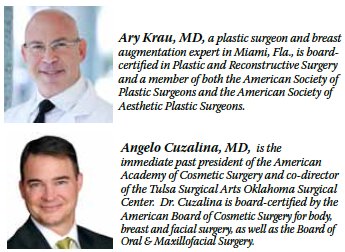

When it comes to breast implants, choosing to go forward with this popular procedure (about 307,000 in the U.S. last year) is just the first of many decisions you’ll have to make. You’ll also have to select type (saline or silicone), the size of the implant, whether you want the implant placed above or below the muscle, and perhaps most importantly, where your incisions will be.
Incisions? Yes. Implants require them, and their size and location can be critical when it comes to avoiding the appearance of scars.
Fortunately there are options for incisions that are so well hidden that you might not even be able to see them once they’re healed—and they leave no signs of surgery on the breasts themselves. According to Tulsa, Oklahoma cosmetic surgeon (and past president of the American Academy of Cosmetic Surgery) Angelo Cuzalina, MD: “Different patients have different definitions of ‘minimal-scar’ surgery. But for some women, a scar on the breast just isn’t acceptable.”
Carla Williams, 40, was one of these women, and she decided to get breast implants placed through an armpit incision after having two children. “I loved how my breasts looked when I was pregnant,” she says. “After I gave birth and lost a lot of weight, I wanted them back! But I didn’t want scars on my breasts, and now I can only see them if I really, really look.”
Let’s Get Minimal
Unlike traditional breast augmentation procedures that utilize incisions under the breast or around the nipple, these minimal-scar techniques require greater skill on the part of the surgeon, so it’s the patient’s responsibility to make sure her doctor is experienced. Above all don’t try to sway a surgeon to take one of these approaches if he or she isn’t comfortable with the techniques. If that’s the case, find another surgeon who is.
Miami, Florida plastic surgeon Ary Krau, MD, has mixed feelings about these “distal” approaches (which means distant, or away, from the breast). “For the straightforward patient with no sagging and no need for muscle work, these approaches can garner a good result. But I don’t think these approaches offer the surgeon the best opportunity to place the implant optimally,” he explains. “And as we all know, there is a high revision rate for breast augmentation—even if just to change the size—and it’s hard to do revisions through these distal incisions.” This means that taking a minimal-scar approach may still require a traditional incision down the line.
The Options


The Funnel: Another innovation to keep incision length to a minimum is the Keller Funnel. Designed to help insert silicone implants, the funnel propels the implant into the breast, resulting in less trauma than when a surgeon uses his fingers. “The Keller Funnel is an innovative new device that is designed to deliver silicone gel implants into the breasts in a less traumatic manner, allowing plastic surgeons who use it to reduce the size of the incision and the trauma associated in placing implants,” says Manhattan, NY, plastic surgeon Adam Schaffner, MD. Plus, there are fewer complications with a no-touch technique that minimizes the risk of bacterial contamination.
The Belly Button: Officially known as the trans-umbilical, or TUBA breast augmentation, this technique requires an incision about two-thirds the way around the belly button. The surgeon creates a tunnel from there to the breasts, through which he inserts a rolled-up saline implant. (The implant is filled once in place.) Once healed, the incision is barely detectable. The caveats: Silicone implants cannot be used, and according to Dr. Cuzalina, “If the patient doesn’t have a lot of fat on her stomach, she may not be the best candidate.” Also, implant warranties may be void since they are more prone to damage with this approach.
Mommy Add-On: Officially known as the transabdominoplasty, or TABA technique, this is when the breast augmentation is performed at the same time as a tummy tuck (also known as the “mommy makeover”). This has soared in popularity, with surgeons using the same tummy tuck incision along the pubic bone to place saline or silicone implants either above or below the muscle. The caveats: This approach is not suitable for all patients, and it is not an option if a breast lift is necessary.
Around the Nipple: Another alternative is the ‘intra-areolar’ incision, which uses an accordion-shaped incision in the dark area that surrounds the nipple. This technique, pioneered by Sarasota, Florida-based cosmetic surgeon Leonard A. Rubenstein, MD, seeks to avoid telltale scars. “This skin doesn’t form scars like normal skin because there are fewer sweat glands and less fat in the tissue,” says Dr. Rubenstein. Dr. Krau, on the other hand, believes these scars can be noticeable, and has concerns because this “extremely rare” technique requires an experienced surgeon.
Regardless of which technique is used to insert the breast augmentation, “The incision is just the means to get the implant in,” says Dr. Cuzalina, so recovery from these minimal-scar techniques is comparable to traditional incision placement.
But there may be another advantage in terms of complications, Dr. Cuzalina explains. “Some doctors believe there’s a lower rate of infection when the incision is away from the breast,” he says. “This could be due to the fact that the implant can be placed with a no-touch technique, or because there isn’t as much cutting with smaller incisions.” Doctors also report less risk of losing sensitivity in the nipple, because the nerves at the base of the breast are less likely to be cut or damaged than with traditional methods.
These risk-related benefits aside, the scars—or lack thereof—are the real advantage. “I have no regrets whatsoever,” says Williams. “I love them, and I love my bikini time!”












